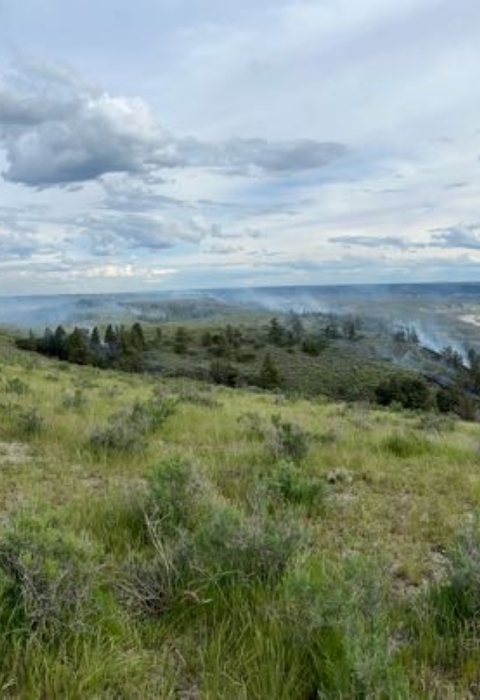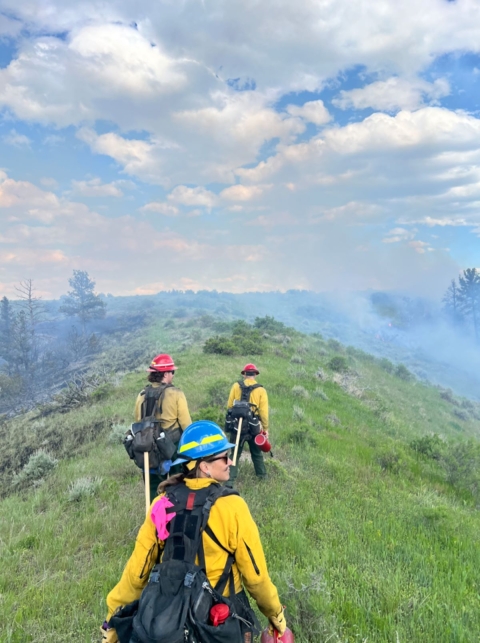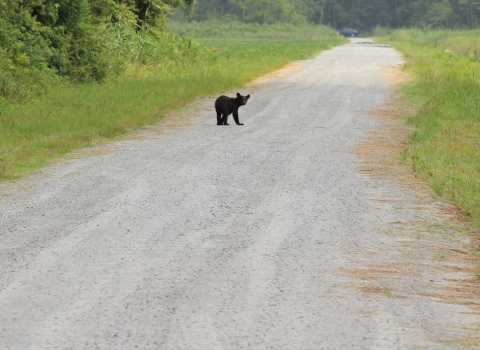To reduce the threat of catastrophic wildfire, in May 2024 U.S. Fish and Wildlife Service (Service) fire managers joined other federal and state wildland fire personnel in conducting what may be the largest prescribed fire in Montana history. The 9,962-acre fire included 6,687 acres managed by the Service, 2,890 acres managed by the Bureau of Land Management, and 59 acres managed by the Montana Department of Natural Resources and Conservation. Clearing the buildup of hazardous fuels at the start of wildfire season reduced wildfire risk and improved wildlife habitat.
Funding for the prescribed fire came from the Bipartisan Infrastructure Law Bipartisan Infrastructure Law
The Bipartisan Infrastructure Law (BIL) is a once-in-a-generation investment in the nation’s infrastructure and economic competitiveness. We were directly appropriated $455 million over five years in BIL funds for programs related to the President’s America the Beautiful initiative.
Learn more about Bipartisan Infrastructure Law (BIL), signed into law November 2021. The Department of the Interior directed $11 million in BIL funding to reduce catastrophic wildfires through measures such as prescribed fire.
Much of the 9,962-acre prescribed fire occurred on the 1.1-million-acre Charles M. Russell National Wildlife Refuge – a wild and rugged landscape of canyons, ravines, and badlands. The refuge is the largest in Montana and the second largest in the lower 48 states, behind Desert National Wildlife Refuge in Nevada.
Located along the Missouri River surrounding the Fort Peck Reservoir, Charles M. Russell Refuge was established in 1936. It was originally called the Fort Peck Game Range. It was renamed in 1963 for Montana artist Charles M. Russell, a famous painter of the American West. In 1976, the "range" was reclassified as a "refuge," and its management turned over to the Service.
Vast and remote, the refuge has changed little from the time of the Lewis and Clark Expedition of 1805. The refuge contains more than 175,000 acres of designated and proposed wilderness, where resident wildlife include elk, mule and whitetail deer, pronghorn antelope, bighorn sheep, mountain lion, sage and sharp-tailed grouse, and bald eagles. The refuge uses a variety of fuels management actions to minimize wildfire severity, restore wildlife habitat and maintain the landscape.
Fire personnel from the Service’s Montana Fire Zone, the Bureau of Land Management, USDA Forest Service, and Montana Department of Natural Resources and Conservation jointly conducted the prescribed burn prescribed burn
A prescribed burn is the controlled use of fire to restore wildlife habitat, reduce wildfire risk, or achieve other habitat management goals. We have been using prescribed burn techniques to improve species habitat since the 1930s.
Learn more about prescribed burn . Because of the location, geography and fuel type, this type of prescribed fire is known as a landscape-scale burn. Landscape-scale burns are usually large and are bounded by existing natural or constructed fuel breaks, such as waterways, roads, or rock outcroppings. These burns are planned, and generally include adding fire to the landscape at different times, scales, and intensities.
“Charles M. Russell National Wildlife Refuge has a long history of fire suppression, which has allowed for an overgrowth of Rocky Mountain juniper trees in places they historically haven’t been, like upland areas and grasslands,” said Jim Forsythe, Montana Fire Zone fire management officer. “The overabundance of Rocky Mountain juniper has contributed to extremely hot and intense wildfires at the refuge. The goal with this landscape burn was to reduce stands of juniper, while also reducing small amounts of other types of timber, including Ponderosa pine and Douglas fir ensuring an adequate amount of winter coverage for big game species remains. This prescribed fire helped us reduce those hazardous fuels to restore landscape resiliency, while also providing critical habitat for refuge wildlife.”
A lot goes into planning prescribed fires, especially ones as large as this. Planning begins years in advance and includes numerous discussions with the community, stakeholders, and federal and state fire partners. Plans cover how to prepare the landscape, whether to create firebreaks or use existing natural ones, whether to thin excess vegetation by machine or by hand, and when and where to put fire on the ground.
Other considerations are discussed, too, such as the presence of invaluable natural and cultural resources that could be damaged by heat or flames.
“The refuge is extremely rich in cultural and natural resources,” said Forsythe. “Knowing the refuge is home to fossilized dinosaurs, historic sites from the Lewis and Clark Corps of Discovery, settlements from over 100 years ago, and native artifacts, such as teepee rings and other religious sites, we worked very closely with refuge resource staff to identify and protect these areas from any impact from the prescribed fire.”
To light such a largescale burn, fire managers used a combination of helicopter ignitions and ground ignitions. Helicopter ignitions include the use of a plastic sphere dispenser, affixed to the floor of the helicopter. The machine releases plastic spheres to ignite natural material on the ground, such as pine needles and grasses. The spheres are filled with an oxidizing agent. Just before release, glycol is injected into each ball. The glycol interacts with the oxidizing agent, and about 30 seconds later, the sphere catches fire and ignites the fuel on the ground. Ignitions of this type result in many small fires that grow together in a way that provides corridors for wildlife to escape and are gentler on vegetation.
This prescribed fire effort underscores the value of collaborative planning and resource allocation in safeguarding our landscapes for future generations. National wildlife refuges across the country testify to the resilience of our natural systems and the enduring commitment to their preservation.







